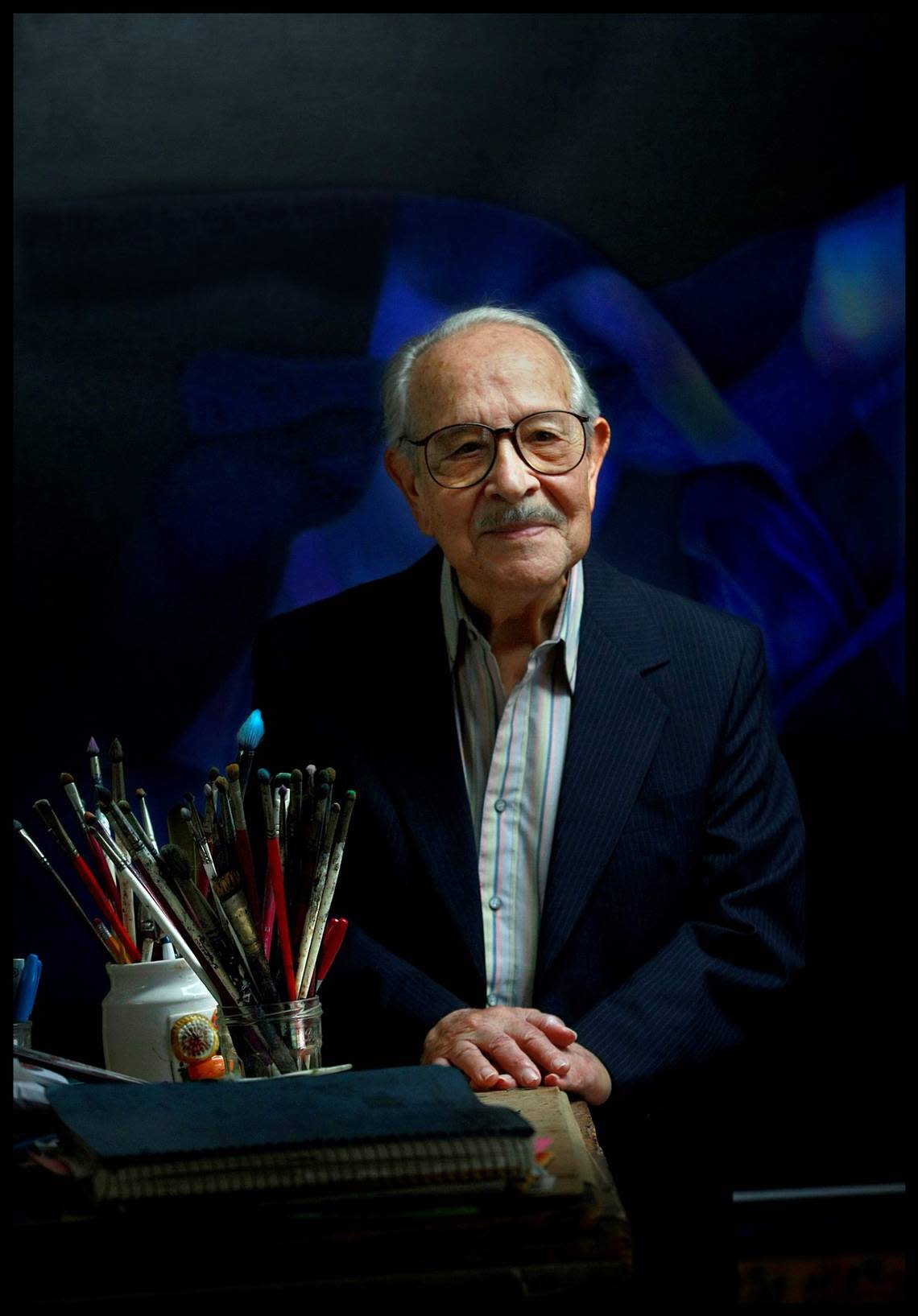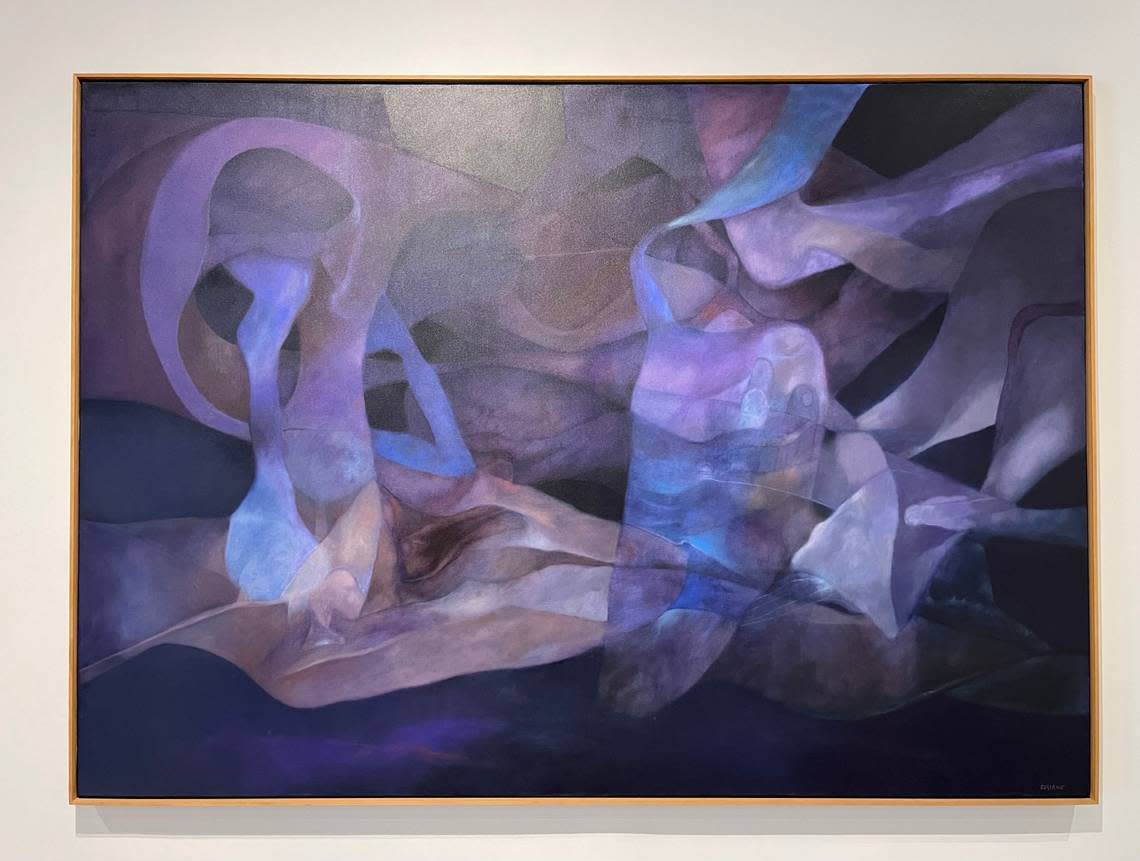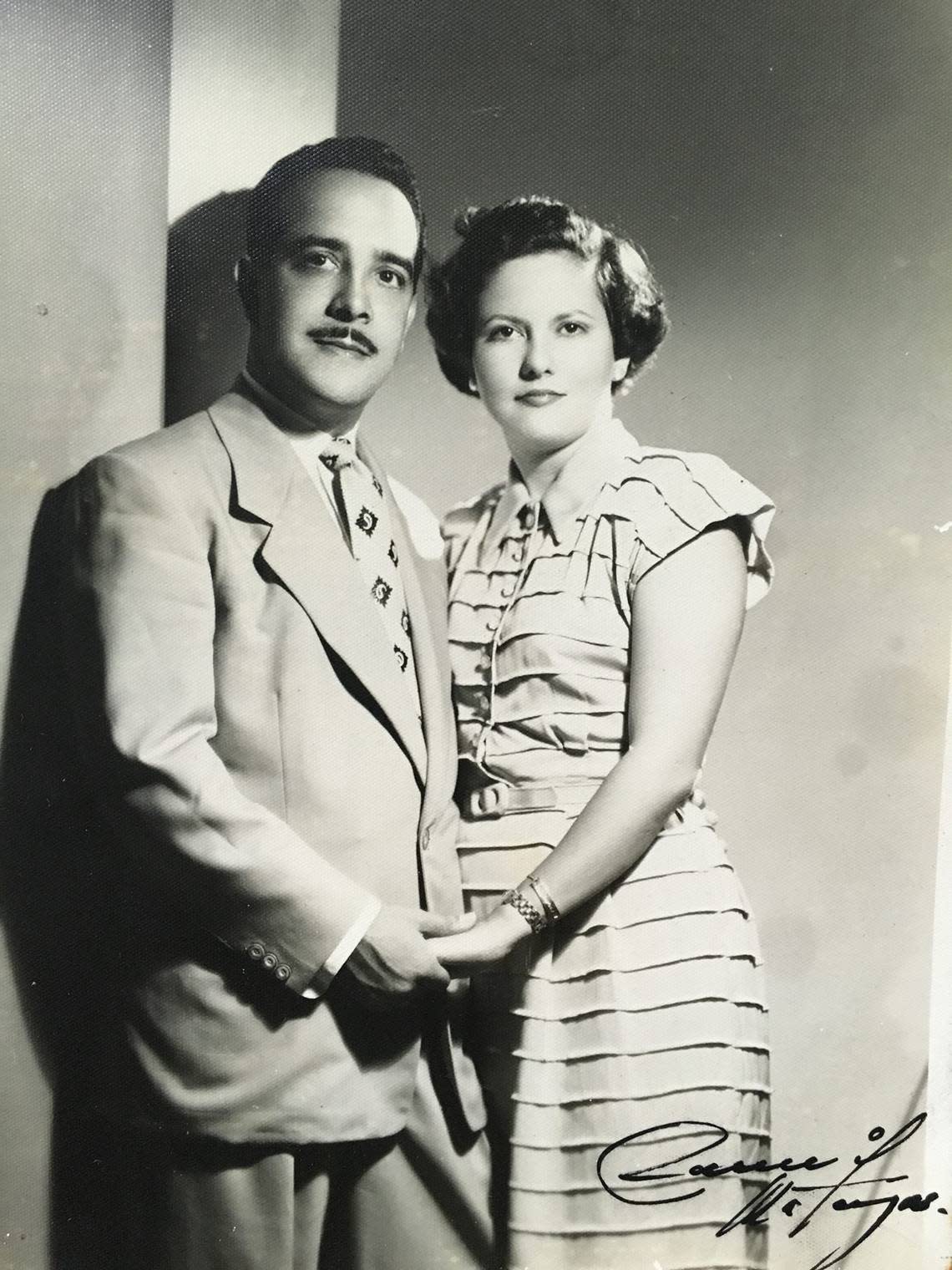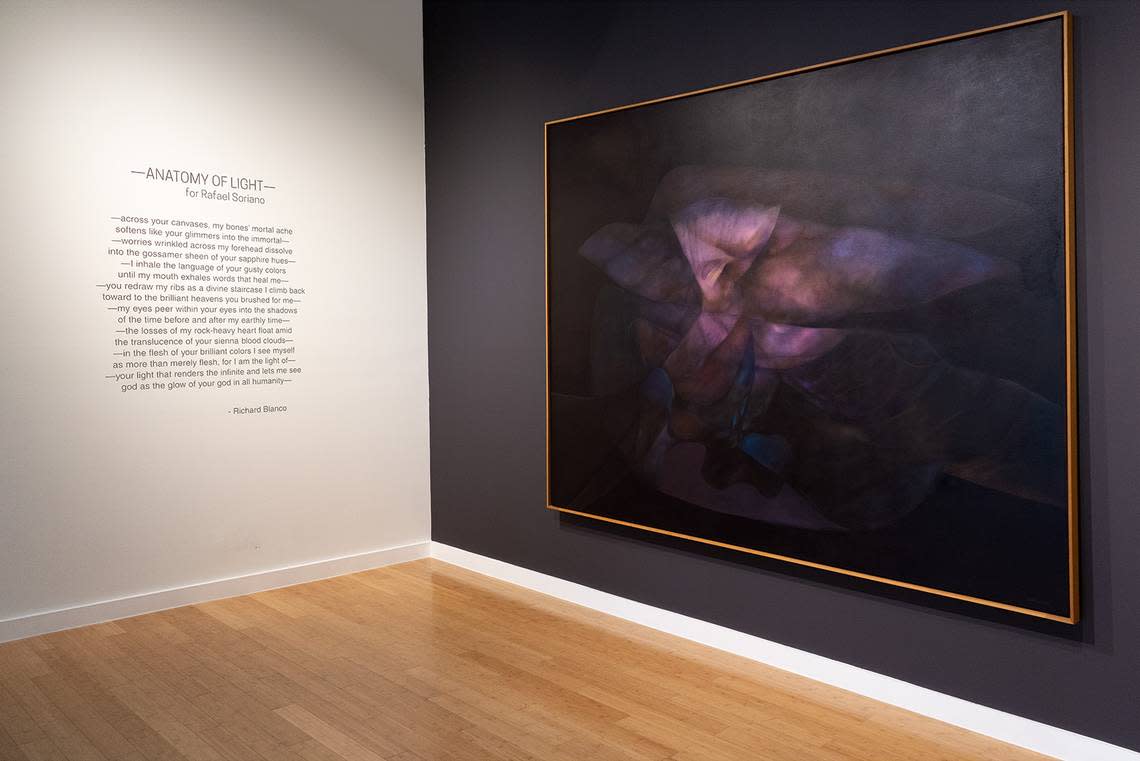From exile to the Holy Spirit: Miami art gallery celebrates late Cuban master in exhibition
Not everyone makes it through life truly satisfied. Rafael Soriano did.
The Cuban artist made a name for himself both in his estranged home country and in his new home of Miami. For over 60 years, he mastered his own style of surrealism and a technique that turned oil paintings into glimpses of another universe. But one day, in 2000, he decided that he had painted his last work.
His daughter, Hortensia Soriano, asked him if he was sure. Of course, he responded.
“He said to me, ‘Everything I ever wanted to paint, I’ve already painted,’” she recalled. “He was at peace. My father was totally just Mr. Zen.” He lived for another 15 years, never painting again.
Until February 18, some of Soriano’s final works — the masterpieces that left him satisfied — are on display at LnS Gallery in Miami.

“Transcendentalism, Distilled” is a solo exhibition featuring 15 paintings and three drawings from the last decade of Soriano’s artistic career in the ‘90s. The gallery selected the pieces in the show with curator Sofia Guerra and The Rafael Soriano Foundation, which the Soriano family created to preserve and promote his artwork, said Sergio Cernuda, the gallery director.
Soriano’s abstract works, which are rich in color and deep in symbolism, are difficult to describe, but his career speaks for itself. A pioneer of Latin American modernism, Soriano is featured in renowned permanent museum collections, including the Smithsonian American Art Museum in Washington, the Museo Nacional de Bellas Artes in Cuba, Museo de Antioquia in Colombia and the Pérez Art Museum Miami.
Soriano was “the Rothko for us, for the Cuban American artists,” Cernuda said. His visual language was unique. His use of color was masterful. His paintings, including every single work on display at the gallery, look as though they are illuminated from the inside.
“This is somebody who understood shadows and lights and color theory like very few artists of the 20th century did,” Cernuda said.
Cernuda credited the exhibition to Hortensia’s efforts to archive her father’s paintings and cement his legacy as a seminal figure in Miami’s artist community. The show was the perfect fit for LnS because the gallery aims to highlight “the young history of the Miami art scene,” which boomed following a massive exile of Cubans in the 1980s, he said.
“The ‘80s in Miami is a really fascinating time,” Cernuda said. “Soriano was at the epicenter of all of it assisting a lot of young artists because he had already been here for so many years.”
But the show also serves as a love letter to Hortensia’s parents and their story. Milagros, Hortensia’s mother who died in October, was her husband’s biggest supporter and collaborator. She mounted his canvases and built his frames. The couple named the paintings together. The exhibition’s catalog was dedicated to Milagros.
“For me, it’s an emotional, amazing moment to see these beautiful 1990s late style works of his here in this beautiful space,” Hortensia said.
Hortensia, a retired chiropractic physician, grew up surrounded by these paintings, even into adulthood. At the gallery, she sat on a small bench in front of “Espejismos de agua,” a large deep blue and purple mirage her father painted in 1990. For years, she would sit at her Miami Beach home staring into the painting while sipping her morning coffee.
“I don’t have to dive into the bay,” she said. “I dive into this painting.”
Now, she’s ready to part with it. The pieces on display are for sale, particularly to art collectors or institutions who are dedicated to preserving the work. Her father’s work is meant to be shared, she said.

Love in a streetcar
Rafael always knew that he was born to paint. The first time he saw a painting as a child, he told Hortensia, he pointed at it and announced that that was what he wanted to do.
He came from humble beginnings in Matanzas, Cuba. His parents supported his creativity and he studied at Havana’s prestigious yet stringent Escuela Nacional de Bellas Artes San Alejandro. As a young man, he later founded his own prestigious (and less strict) art academy, the Escuela de Bellas Artes de Matanzas. There, students were free to explore their creativity, Hortensia said. He taught as a professor and served as director.
That is where he met his future wife, or more accurately, where his future wife first spotted him.
“My mom stalked him!” Hortensia said, laughing.
Their love story began on a streetcar, she recounts. Milagros saw him get off at the stop in front of the academy and followed behind. She asked someone outside the building about who that man was. She got his name and occupation: Professor Rafael Soriano.
When she got back home, her mother noticed she was practically floating. Milagros told her that she saw the most beautiful man in the world. “Oh, he must have been tall, blue eyes, blond hair,” her mother said. Nope.
“What did you see in him?” her mother asked.
“I saw light in his forehead,” Milagros said. (While telling this story, Hortensia glanced at a large painting in the gallery that glows from its center, as if a flashlight was behind the canvas.)

From that moment, Milagros was on a mission. She sat on that streetcar everyday until Rafael finally sat next to her and said hello. Rafael’s career grew, and the couple built a life together in Matanzas, where Hortensia was born.
But their fairy tale romance was met with a harsh political reality. Soriano was on the verge of international recognition when he had to leave his career, academy and home behind. In 1962, the small family fled to Miami in exile.
A holy encounter
Like many Cuban exiles at the time, Rafael thought that the move to Miami was temporary. His bags were packed and ready to go. He longed to return home.
For a while, he just didn’t feel like painting. He was traumatized, Hortensia said.
But one day, his perspective changed overnight. He told his daughter he was visited by the Holy Spirit in a dream.
A figure asked Rafael where he wanted to go, and he requested to see his little house in Matanzas. At the speed of light, the figure transported him back to the hill his house sat on. He watched in fear as a stampede of wild horses barreled toward his home. He asked the figure, “Who are you?” The figure responded, “I am the Trinity.”
When Rafael woke up, his decision was made. He told his wife that their life in Cuba was over. They were settling in Miami for good.
“Did it really happen? It doesn’t matter,” Hortensia said. “For him, it was life changing. It was a pivotal moment in his life that allowed him to continue his work in a newfound land, in freedom.”
His encounter with the Holy Spirit and his acceptance of his life in Miami marked a shift in his artwork. His paintings became more spiritual and otherworldly. He would get home from work, play some Grace Jones and paint through the night, Hortensia said.
As he established himself locally and nationally, he helped emerging artists find their footing. Several Miami-based artists have fond memories of Rafael taking them to an art supplies store to buy materials or helping them figure out business contracts, Cernuda said. He never stopped teaching.
Sharing a legacy
The focal point of the exhibition is in a glass room in the gallery’s center. Inside is “Ave inventando la ausencia,” a dark yet illuminated abstract painting of a bird.
Soriano’s spirituality is especially tangible in this piece. Birds are often symbols of flight, afterlife, memory and transcendence, Cernuda said. The painting itself inspires moments of meditation and reflection.
Richard Blanco, Miami-Dade’s first poet laureate, wrote a poem inspired by Soriano’s work for the exhibition. The poem is printed on an adjacent wall. It reads, “in the flesh of your brilliant colors I see myself as more than merely flesh, for I am the light of your light that renders the infinite and lets me see god as the glow of your god in all humanity.”

Soriano’s colors are brilliant. The purple is so deep it’s almost black. Bright white spots illuminate funky shapes. Yellow peeks through rich reds. His palette was inspired by the sunrises and sunsets in Matanzas, Hortensia said.
His shapes are something else entirely. One painting looks like a beating heart. Another looks like a bits of a skeleton poking through outer space. Another looks like an alien.
Though the exhibition is small, it manages to capture the essence of a truly unique artist with an unwavering confidence. Visitors can experience Soriano’s paintings in the way Hortensia did, as adventures.
“He transcended here, and we can see that in these paintings,” she said. “I hope that gives people hope that there is something beyond this world.”
‘Transcendentalism, Distilled’ by Rafael Soriano
Where: LnS Gallery, 2610 SW 28th Ln., Miami
When: On view until Feb. 18.
Info: Free entry. Walk-ins welcome. lnsgallery.com
This story was produced with financial support from The Pérez Family Foundation, in partnership with Journalism Funding Partners, as part of an independent journalism fellowship program. The Miami Herald maintains full editorial control of this work.
